The future of cloud computing: Top trends and predictions
Expect GenAI, IoT, cloud-native, edge computing, power-hungry data centers, data-hungry LLMs, FinOps and privacy laws to shape public cloud's future as a viable service model.
The cloud has evolved over the past several decades from cheaper alternatives for provisioning VMs to a more nuanced and complex infrastructure. Although the cloud today might not always be the less expensive alternative in terms of raw infrastructure costs, the technology still holds considerable promise for improving data integration, business analytics and the development of AI applications and services.
AI will play a definitive role in shaping the way enterprises use and develop cloud infrastructure. The insatiable demands for huge amounts of data to feed new AI systems will necessitate moving different types of workloads to the cloud. But this migration also introduces many new challenges as AI concerns foster new regulations that will affect many cloud use cases. Expect several trends to shape the future of cloud computing.
1. Cloud not always the cheaper option
Public cloud computing has had the reputation of being less expensive than existing managed IT services. It also has provided various ways to improve integration across multiple enterprise apps and services. But these initial cost advantages have been offset by cloud vendor approaches to monetizing their investments, resulting in cost increases for businesses.
The underlying costs of cloud-based storage and networking have declined significantly, while cloud service and egress charges, in some cases, have increased. Also, moving workloads to the cloud is more expensive than a decade ago due to recent contractual changes by the likes of VMware.
Many organizations also need to contend with technology investments, such as physical data centers, which typically have long-term contracts and legacy business applications that could require significant rework or redesign, said Chris Vogel, advisory services CIO at consultancy S-RM. "Large organizations that have decades-long legacy technology investments and technology debt," he explained, "will have a much larger lift in moving to cloud-based models."
The COVID-19 pandemic served as a wake-up call for businesses to accelerate the modernization of their infrastructure to support e-commerce transactions, customer service, hybrid workforces and AI processes. Modernization efforts have "since been rationalized back to more normal levels and rates," Vogel said, "but the need to invest in technology remains strong today, and cloud plays a large role in that."
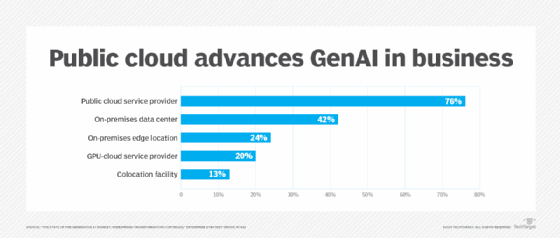
2. AI sparks cloud data imperative
The launch of OpenAI's ChatGPT opened new possibilities for extremely large data sets, particularly unstructured data. But training, fine-tuning and priming them with precise snippets using retrieval augmented generation call for new and better ways to stage different data types adjacent to generative AI (GenAI) systems. Enterprises have embraced the attitude that "data is the new oil," which has inspired the growth of disorganized data lakes. Pursuing GenAI will demand more refined approaches to data organization, quality assessment, management and integration.
"Data is king, and AI's ability to process enormous quantities of data is now seen as a strategic priority for most organizations," Vogel said. GenAI is influencing the products and services that businesses provide their end users and customers. The vast quantities of data that GenAI and other machine learning technologies require make the cloud the most viable scalable option. "The feasibility of running AI capabilities from traditional on-premises infrastructure is simply not cost-effective, paving the way for cloud-based solutions where infrastructure is virtually limitless," Vogel added.
3. Plan for varieties of AI
Enterprises are starting to prepare for different types of AI, said Dipankar Sengupta, CEO of digital engineering services at AI and automation platform provider Sutherland. Among the various types of AI applications are classical, generative and autonomous. In anticipation, cloud providers are optimizing their infrastructure accordingly.
As AI and GenAI tools are integrated into cloud services, expect to see a proliferation of prebuilt and, more importantly, pretrained models made available to businesses without the need for in-house AI expertise or capabilities. Sengupta sees a rise in the AI-as-a-service model exemplified by Amazon SageMaker, Google Cloud AI and Azure Machine Learning.
Security and data protection practices will be increasingly critical as a result of adopting these services. "This will be incredibly important to monitor as these services continue to evolve," Sengupta surmised.
4. GenAI prompts greater IP protection
Consumer AI services often come with disclaimers that the data they collect might be used to improve AI systems in the future. As GenAI permeates most aspects of business, expect corporate lawyers, for example, to more closely vet contracts to ensure the company's proprietary data is protected, said Srinivasan Swaminatha, managing director of data modernization at consultancy TEKsystems. All the large language models (LLMs) provided by major cloud vendors, he explained, come with a notice that "your data remains secure." But it will become increasingly incumbent on legal, compliance and IT teams to ensure the AI system components are carefully architected to prevent data leakage. Many large businesses are laying off workers who know the company's secret sauce.
5. IoT and edge to cloud support new use cases
When the cloud first emerged, the focus was on making it easier for enterprises to migrate all their existing IT processes into a more centralized infrastructure. Businesses and vendors have increasingly discovered that this approach doesn't always make sense. Newer governance requirements, for example, implore enterprises to run many workloads on-premises. Also, IoT use cases involving factory equipment and autonomous vehicles could require running workloads outside the centralized infrastructure to reduce latency and lower AI training costs.
"The last decade has seen the advent of IoT in more and more applications and businesses," Vogel said. IoT devices reporting data to a centralized location for processing is rapidly being enhanced or replaced by edge computing. This shift requires moving processing power to the edge of the network and closer to the endpoints to speed processing and deliver results more efficiently. In addition, bandwidth can often be reduced and business intelligence accelerated with edge computing.
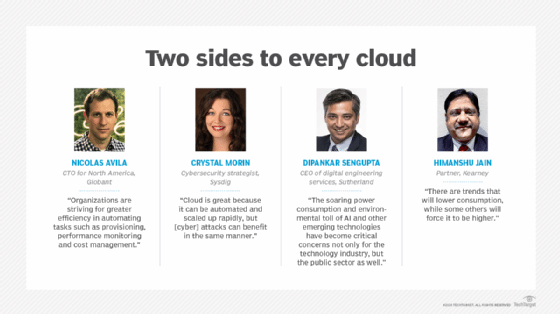
6. Data center and AI proliferation raises environmental concerns
Traditionally, IT has had a negligible carbon footprint compared to construction or transportation. But AI requires a lot of power, prompting heightened scrutiny of cloud data centers. While touting their net-zero or low-carbon data centers because they're buying solar power, some cloud providers might gloss over the impact of connecting a solar field hundreds of miles away or the effects of their water consumption on local communities.
The rapid proliferation of data centers threatens to raise power and water rates for communities forced to pay for new power plants, run new wires and install new water infrastructure for cloud providers. Nuclear power plants as a cleaner source of energy might provide the necessary power for AI applications and reduce emissions, but storing the nuclear waste for the required 10,000 years is still problematic.
"The soaring power consumption and environmental toll of AI and other emerging technologies have become critical concerns not only for the technology industry, but the public sector as well," Sengupta warned. Although in its infancy, quantum computing could further compound these concerns. Sengupta suggested businesses should look for authentic green cloud initiatives to offset their carbon footprint, possibly leading to additional cloud arrangements, such as multi-cloud or hybrid cloud ecosystems -- the complexities of which could increase the need for hyperautomation in cloud ecosystems.
7. Multi-cloud and hybrid cloud investments demand more oversight
Cloud vendors are looking for more creative ways to monetize their investments and turning to multi-cloud and hybrid cloud environments, Vogel reported. These approaches enable businesses to tailor their cloud services to specific needs and requirements to distribute workloads optimally. They also limit single-vendor exposure and increase price competitiveness. Cloud orchestration tools help manage these diverse environments and reduce the impact on operations.
"The overall budget that companies have to set aside for cloud services continues to grow, influenced by AI, edge computing and overall data growth," explained Kate Obiidykhata, solutions marketing manager at open source database provider Percona. In the wake of rising costs, she surmised that those running cloud services will be under greater pressure to justify their investments, improve efficiency in their workloads, move to other cloud services or drop the cloud. A multi-cloud mindset will require additional management challenges, standardization of tools and better processes for ensuring security and compliance across multiple regions.
8. AI cloud spawns new security challenges
Cloud vendors are improving the security posture of their platforms, but those improvements don't always align with the way security professionals manage emerging threats. IBM's 2024 data breach report found the global average cost of an enterprise breach was $4.88 million, compared to $5.17 million for a public cloud breach because of the speed and scalability of cloud platform cyberattacks. "Cloud is great because it can be automated and scaled up rapidly, but those attacks can benefit in the same manner," said Crystal Morin, cybersecurity strategist at cloud security platform provider Sysdig.
GenAI is also accelerating efforts to compromise LLM accounts. The Sysdig Threat Research Team estimated at the beginning of 2024 that the potential cost could reach $40,000 per day for cloud bills associated with the latest LLM services. In less than six months, that figure has swelled to $100,000-plus per day for the latest versions of LLMs. Those costs can be incurred quickly. Businesses must improve their surveillance techniques to prevent attacks before they can scale up, Morin suggested; otherwise, these costs will grow as LLMs running in the cloud increase.
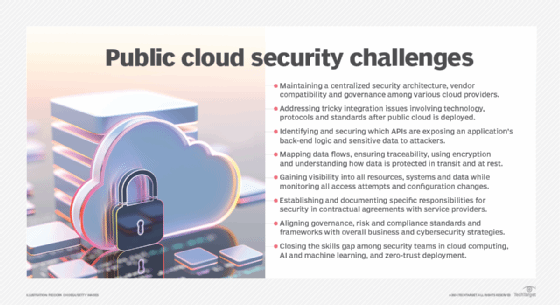
9. The cost to lower cloud consumption will rise
Many AI workloads are moving to the cloud, but other IT workloads are on-premises to reduce costs, said Himanshu Jain, partner at consultancy Kearney. "There are trends that will lower consumption," he explained, "while some others will force it to be higher." Yet, he expects overall cloud budgets will increase.
Factors lowering cloud consumption include refactoring workloads to utilize cloud-native capabilities and FinOps practices that drive efficiency, Jain said, but these benefits will come at increased costs associated with migrating new and more complex AI workloads. Many companies, he reported, are budgeting for a 10% to 20% increase in cloud bills over the next couple of years.
Multi-cloud strategies to reduce vendor lock-in and improve business continuity could add to these costs. One large retailer, according to Jain, developed a multi-cloud strategy to increase resilience, which also increased spending by up to 10% due to this risk diversification strategy.
10. More efficient query performance techniques optimize data stores
Cloud infrastructure supports multiple ways of organizing data, including virtual disks, objects and various types of data stores. AI is increasing the size and rate of updates of these stores -- not to mention cloud costs. Enterprises will increasingly look for ways to improve query performance and run queries more efficiently, Obiidykhata said, without scaling up to larger instances. Old school data management skill sets, she predicted, will be more valuable because they can tie various configurations to specific and achievable savings. Expect greater demand for database administrators.
To manage new workloads and the cloud, more businesses are using databases on Kubernetes alongside their applications. As a result, developers and IT operations teams need only manage one platform at a time rather than integrate containerized applications with cloud-based database machines or database as a service (DBaaS) options. "Using Kubernetes and open source databases means that you are not locked into a specific DBaaS or database service, so you have more options over time," Obiidykhata said.
11. Provisioning, monitoring get cloud AI automation boost
"Organizations are striving for greater efficiency in automating tasks such as provisioning, performance monitoring and cost management," said Nicolas Avila, CTO for North America at digital transformation platform provider Globant. The goal is to reduce manual workload and improve accuracy and response times. But automation can also create challenges, such as deciding whether to use pretrained AI or high-quality data for training new models. Best practices include using synthetic data and maintaining collaboration among teams, which will be crucial for successful automation. Also, expect increased integration of AI in cloud management, Avila said, to enable better automation, cost optimization, data analysis and IT support in decision-making, predicting trends and personalizing experiences.
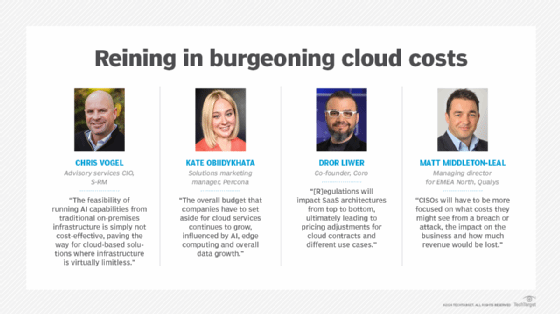
12. Governance, compliance challenges burden cloud management
The broader adoption of AI and their regulations will further burden cloud management. More attention will be paid to how businesses use AI and secure their AI platforms, Morin conjectured. IT managers and compliance teams will need to embed these platforms securely into their operations and the pools of data feeding AI models.
Expect more national and regional government data privacy regulations driven by GenAI adoption, said Dror Liwer, co-founder of cloud-based cybersecurity platform provider Coro. "These regulations," he explained, "will impact SaaS architectures from top to bottom, ultimately leading to pricing adjustments for cloud contracts and different use cases."
Regulators are evaluating better ways to apply and enforce existing laws, such as GDPR and HIPAA, and newer regulations, like the EU's AI Act and Digital Operations Resiliency Act, India's Digital Personal Data Protection Act and the California Consumer Privacy Act.
What cloud computing skills will be required in the future?
More sophisticated tools are emerging to simplify many aspects of managing operations in the cloud, which will require new skills. "I think an understanding of systems, systems architecture and component interaction is going to be ever more critical," reasoned Randy Armknecht, managing director of cloud engineering at consultancy Protiviti. "Individual component choices will be ever-evolving, but the higher-level understanding of how a system achieves desired business outcomes will be a skill that lasts." Prompt engineering skills, he added, could also become essential for simple chatbot queries, feeding AI applications, and example coding for deploying and configuring cloud services.
In addition, there will be greater demand for data center modernization skills to retrofit facilities built a decade or two ago, said Pranav Sharma, principal at Kearney. With broader adoption of infrastructure as code for provisioning and automating infrastructure, cloud practitioners will need to learn DevOps and modernization skills.
Also, expect increased demand for cloud security skills that cover tooling and processes, said Matt Middleton-Leal, managing director for EMEA North at cloud security and compliance platform provider Qualys. He believes the skills mix for CISOs will change in 2025 with greater emphasis on risk quantification and management best practices. Part of that focus will be on managing the rising cost of cyber insurance. "CISOs will have to be more focused on what costs they might see from a breach or attack, the impact on the business and how much revenue would be lost, while also being able to put monetary figures on how their security strategies prevent and reduce those losses," Middleton-Leal explained.
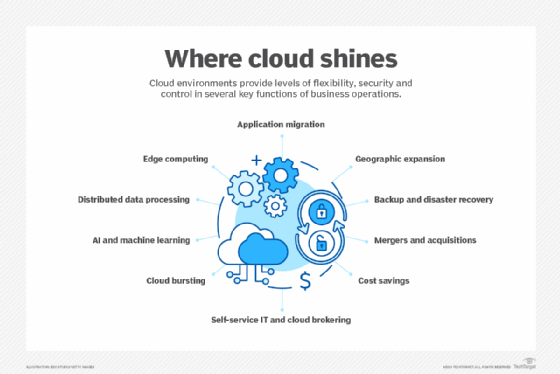
Future of cloud computing
As a concept, the cloud will not likely be replaced any time soon. But how and where organizations create, deploy and manage apps and workloads will continue to evolve. New approaches to provisioning and automation are likely to shape the future of cloud infrastructure.
Early cloud implementations focused on monolithic approaches by running traditional applications on VMs. Attention has turned to deployments in smaller doses to support Agile development processes. Microservices, for example, enabled teams to create an ecosystem of more modular apps, while serverless platforms provided a way to call stateless apps as required. Both approaches had limitations, including complexity, integration and management challenges.
Cloud platforms will repurpose the WebAssembly, or Wasm, format for running high-performance apps on browsers to support the WebAssembly System Interface, or WASI, that could run on cloud platforms, according to Forrester Research. This trend could provide the benefits of more modular development that overcomes some of the limitations of microservices and serverless approaches.
Expect interconnected ecosystems to become the norm, Sengupta said. Secured integration across cloud platforms, IoT networks and connectivity layers could help enterprises unlock the full potential of secure and transparent customer service, enabling new business models and revenue streams.
The future IT computing model will gradually progress from on-premises infrastructure to cloud and edge computing, acknowledged Vishal Ghariwala, senior director and CTO of Asia Pacific at open source Linux software provider SUSE. Businesses will need to develop the technical skills required to unify on-premises, cloud and edge environments that accommodate cloud-native development approaches, maximize AI applications and support a solid security foundation.
George Lawton is a journalist based in London. Over the last 30 years, he has written more than 3,000 stories about computers, communications, knowledge management, business, health and other areas that interest him.








